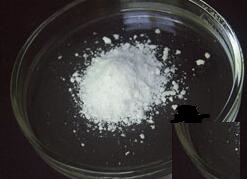|
|
| | INDIUM NITRATE Chemical Properties |
| Melting point | decomposes [AES93] | | density | 1.02 g/cm3 (20 °C) | | vapor pressure | 1Pa at 25℃ | | storage temp. | Store at +15°C to +25°C. | | color | colorless crystals, crystalline | | PH | 0.5 (H2O, 20°C) | | Water Solubility | very soluble [KIR81] | | CAS DataBase Reference | 13770-61-1(CAS DataBase Reference) | | EPA Substance Registry System | Indium nitrate (13770-61-1) |
| Hazard Codes | O,Xi | | Risk Statements | 8-36/37/38 | | Safety Statements | 17-26-36 | | RIDADR | UN 1477 5.1/PG 3 | | WGK Germany | 2 | | RTECS | NL1750000 | | F | 3 | | HS Code | 3822 00 00 |
| Provider | Language |
|
ALFA
| English |
| | INDIUM NITRATE Usage And Synthesis |
| Properties | Indium nitrate (In(NO3)3) is a slightly off-white crystalline powder. It is odorless and dissolves freely in water and lower alcohols.
It is available as an anhydrous powder and in hydrated form with 3 and 4.5 associated moles of water.
 | | Chemical Properties | -80 mesh with 99.999% purity; can be prepared by dissolving In or the oxide in nitric acid [CER91] [KIR81] | | Chemical Properties | The structural formula of indium nitrate is In(NO3)3. It is a
very soluble compound in cold water, is soluble in alcohol,
loses two molecules of H2O at 100 ℃, and decomposes at
higher temperature. | | Uses | In(NO3)3, along with the nitrates of aluminum, gallium, and
thallium, was tested in vitro in mice and rats for cytotoxicity
of tumor cells and for activity against a broad spectrum of
experimental rodent tumors. It is especially effective
for treatment of Hodgkin’s disease and non-Hodgkin’s lymphoma,
and for the treatment of hypercalcemia. Radiogallium
is used for the localization of bone lesions. |
| | INDIUM NITRATE Preparation Products And Raw materials |
|